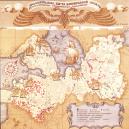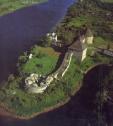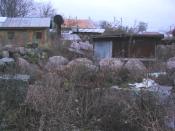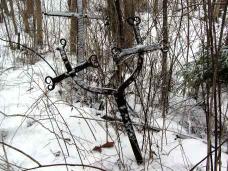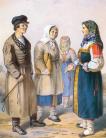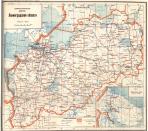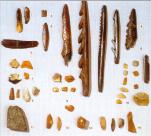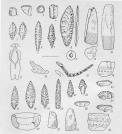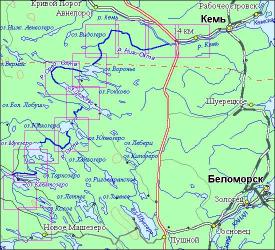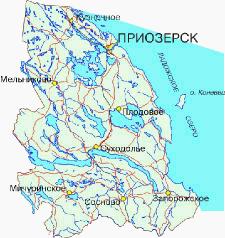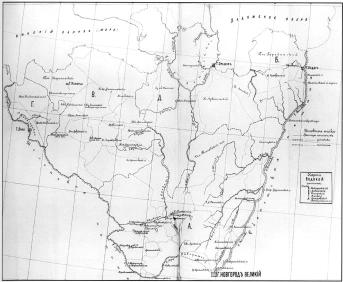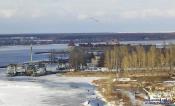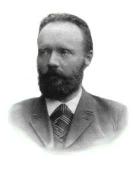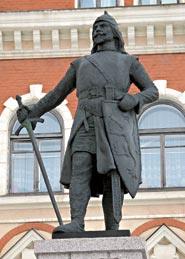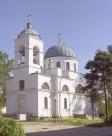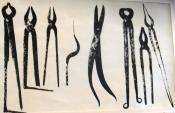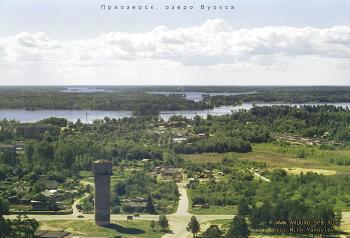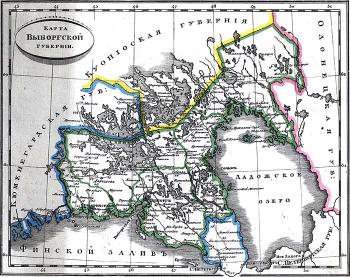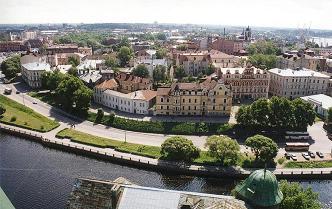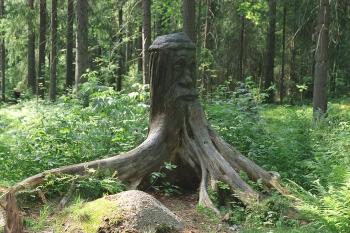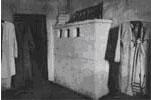|
hidden
|
Ahrenberg, Johann Jacob (1847 - 1914), an architect
Ahrenberg, Johann Jacob (1847, Vyborg - 1914), an architect, writer, ethnographer. During 1870-1875 he learned at the Royal Academy of Free Arts in Stockholm. During 1876-1877 and 1879-1882 he was a teacher of Drawing and History of Arts at the... more
|
|
|
|
hidden
|
Archaeological monuments
Archaeological monuments of the Leningrad Oblast are settlements, grads, burial grounds, religious objects and other material trails of the past. Settling the oblast territory took place during the Mesolithic period. The age of the most ancient... more
|
|
|
|
hidden
|
Ayramoiset, an ethnic group of Ingermanlandia Finns
The Ayramoiset (Ayramoiset, Evremeisy, Evrimeisy) is an ethnic group of the Finns of Ingermanlandia. Descendants of the migrants of the 17th century to Ingermanlandia from the region of Euryapyae on the Karelian Isthmus. The Ayramoiset kept archaic... more
|
|
|
hidden
|
Brodsky, Isaak Israelyevich (1883/1884- 1939), an artist
BRODSKY, Isaak Israilyevich (1883/84 – 1939), artist, collector. In the period 1896–1902 he studied at the Arts College in Odessa. In the period 1902-08 he studied at the St.Petersburg Imperial Academy of Arts, in I.Y. Repin’s class. In the period... more
|
|
|
|
hidden
|
Cemeteries
Cemeteries. The history of cemeteries on the modern Leningrad Oblast territory has not studied practically yet. The reiterated devastation these lands during the wars led to the destruction of many graves and tombstones.... more
|
|
|
|
hidden
|
Cherkasov, Nikolay Konstantinovich (1903- 1966), an actor
CHERKASOV, Nikolay Konstantinovich (1903–1966), theatre and cinema actor, public figure. In the period 1923-26 he studied at the Institute of Stage Arts (modern Theatre Academy), in the class under guidance of S.E. Radlova. In the period 1926-29 he... more
|
|
|
|
hidden
|
Drainage network
HYDROGRAPHIC NETWORK. Over 19500 rivers and 1800 lakes (Ladoga and Onega being the largest ones) form the H. N. of the Leningrad Oblast. The river network is dense and ramified. One exception is the Izhora Hills where the river network density is... more
|
|
|
|
hidden
|
Eparhy of Vyborg and Finland
The Eparchy of Vyborg and Finland. In 1809 Finland was included into the Russian Empire. There were about twenty five thousand members of the Orthodox Church (the majority of members was in the Ladoga rigion) in sixteen parishes of Finland in... more
|
|
|
hidden
|
Eparhy of Korelia
Eparchy of Korelia (Korelian and Oreshsky/Oreshkovsky Eparchy; according to other names - Korelian and Koporsky). It was founded in 1595 after Tyavzinsky Treaty of Peace with Sweden when the town of Korela (now the town of Priozersk) was given back... more
|
|
|
hidden
|
Eparhy of Novgorod
Eparhy of Novgorod. It is one of the oldest eparchies in Russia (it has been being since 992). The eparchy was the largest, it included five administrative regions (pyatinas) as well as the Pskov, Onega Lake, Karelia lands and the region of the... more
|
|
|
|
hidden
|
Farmsteads
FARMSTEADS, settlements (mostly of one homestead), separated into a farm on a plot of land individually owned or used. In the Russian tradition, the term F. as applied to homesteads in Finnish villages of a scattered planning (in particular,... more
|
|
|
|
hidden
|
Finland
FINLAND, country in Northern Europe. Borders Sweden, Norway, the RF (Murmansk Oblast, Republic of Karelia, Leningrad Oblast.) Located on the coasts of the Gulf of Bothnia and Gulf of Finland, Baltic Sea. Area: 338,000 sq. km (abt. 10% being inland... more
|
|
|
|
hidden
|
Finns of Ingermanlandia
Finns of Ingermanlandia (Finns-Inkeri, Finns of Leningrad; old use - Chukhonets, Maimists; their own native names - Soumalaiset, Inkerin Suomolaiset) are an ethnic community. They speak local accents of the eastern dialects (the Baltic-Finnic... more
|
|
|
|
hidden
|
Guro, Yelena Genrikhovna (1877-1913), a poet, artist
Guro, Yelena Genrikhovna (1877-1913), a poet, artist, a representative of the Russian avant-garde. She learned at the Drawing School of the Art Encouragement Society (1890), at the workshop of Ya.F. Tsioglinsky (1903-1906) and then at the school of... more
|
|
|
|
hidden
|
Heraldry of the Leningrad Oblast, the
The Heraldry of the Leningrad Oblast originated from the 15th century and is one of the oldest in the Russian Federation. In the historical-heraldic respect, the territory of the modern Leningrad Oblast is divided into three parts: Karelian Isthmus,... more
|
|
|
|
hidden
|
Ingermanlandia
INGERMANLANDIA (Swed. Ingermanland, Rus. Izhora Land or Ingria), historic and cultural region in the western part of the Leningrad Oblast (Kingisepp, Volosovo, Lomonosov, Vsevolozhsk, Gatchina, Tosno, western part of Kirovsk Districts.) The western... more
|
|
|
|
hidden
|
Izhora (Izhora men)
Izhora (Izhoras, the own native name is Izurit) is an ethnic community. Their language is related to the Baltic-Finnic subgroup of the Finno-Ugric branch of the Uralic language family. Accorging to the most widespread version the Izhora separated... more
|
|
|
|
hidden
|
"Korela", a museum-fortress
"Korela", a museum-fortress (Priozersk Town, 3 Leningrad Road). The first local history exhibition was founded in 1894 in the Round (Pugachev's) Tower of the Keksholm citadel acoording the initiative of the Finnish archaeologist and ethnographer... more
|
|
|
|
hidden
|
Kuznechnoye, urban settlement
KUZNECHNOYE, urban settlement in Priozersk District. Population: 5,200. Located in the north-east of the Karelian Isthmus, at the Lake Ladoga coast, near the borders of the Republic of Karelia and Finland. The name was given in 1948. From 1961, K.... more
|
|
|
|
hidden
|
Leningrad Oblast, the
LENINGRAD OBLAST, subject territory of RF. Area: 83,900 sq. Km (max. Extension from west to east: 446 km, north to south: 325 km.) Population (as of 2002): 1,669,000. The Oblast borders Pskov and Novgorod Oblasts in the south, Vologda Oblast in the... more
|
|
|
|
hidden
|
Local History Editions
Local History editions, on single districts and towns belonged to the Leningrad Oblast on the present days, began to publish in the end of the 19th century. Originally materials on the history of the oblast were published in "Gubernskiye novosyi"... more
|
|
|
|
hidden
|
Maps and plans
MAPS AND PLANS. The oldest M.a .P. of the Leningrad Oblast area are dated 16th century. The Neva Land and the Karelian Isthmus with the towns of Noteborg (Schlusselburg) and Kexholm (Priozersk), although with many distortions, are presented in... more
|
|
|
|
hidden
|
Mesolithic monuments, The.
The Mesolithic monuments. Mesolithic (the Middle Stone Age) is the transitional epoch between the Palaeolithic period and the Neolithic period (in Europe - from c 10000 to 7000 BC). Microlite silicon tools, various goods made of bone and horn are... more
|
|
|
|
hidden
|
Neolithic monuments, The
The Neolithic monuments. The Neolithic (New Stone Age, 8000 - 3000 BC) is the epoch of farming and cattling appearance, spinning and weaving, new techniques of processing of stones and ceramics. In the Eastern Europe forest zone the Neolithics is... more
|
|
|
|
hidden
|
Okhta River, the
OKHTA (Finnish “bear river”), a river in the Karelian Isthmus, largest right-hand tributary of the Neva. Length: 90 km, width: – 30-40 m, predominating depth: 0.5-1 m, max. depth: 5.5 m. Basin area: 768 sq. km. Average flow rate at the mouth: 7.2... more
|
|
|
|
hidden
|
People who spend time at their dachas (holiday cottage in the country).
Holiday visitors (people who spend time at their dachas, holiday cottage in the country) are seasonal population of settlements and horticultural association . The first dachas (summer country dwellings) appeared in the suburbs of S.Petersburg in... more
|
|
|
hidden
|
Population
Population. According to the census of 2002 in the Leningrad Oblast there were 1669,205 thousand people; according to the estimate made on 1 July 2005 there were 1647,6 thousand people including the town dwellers numbering 1093,9 thousand people... more
|
|
|
hidden
|
Priozersk District
PRIOZERSK DISTRICT, municipal entity. Population: 63,300 (of these, 20,500 live in Priozersk town, the adm. center.) Area: 3,563.1 sq. km. Located in the eastern and north-eastern parts of the Karelian Isthmus. It borders Vsevolozhsk and Vyborg... more
|
|
|
|
hidden
|
Priozersk, town
PRIOZERSK (Korela; Kexholm until 1948; Finnish Käkisalmi,) town, adm. center of Priozersk District. Population: 19,300. From 1310, the center of Russian possessions in Karelia. It belonged to Sweden in 1580-95 and in 1611-1710. It became territory... more
|
|
|
|
hidden
|
Pyatinas
PYATINAS, adm. and territorial regions of the core Novgorod Land as part of a united Russian State in the late 15th – 17th century. They are known from written sources (scribe rolls and deeds) from the late 15th century. There were five P.... more
|
|
|
|
hidden
|
Resettlements of the 1945 - 1950s
Resettlements of the 1945 - 1950s were migrations which were caused by political (eviction of some categories of citizens who were considered as unreliable, including the activities for cleaning up the frontier) and economical (the necessity of... more
|
|
|
hidden
|
Russians
Russians are an ethnic community, the main population of the Russian Federation. Among Russians there are some ethnic groups and ethnographic groups can be marked (e.g. Cossacks and Pomors (coast-dwellers (inhabitants of White Sea and Barents Sea... more
|
|
|
hidden
|
Savakots
Savakots (Savakot, Savaki) is an ethnic group of Ingermanlandia Finns. They are descendants of the migrants resettled in the 17th century to Ingermanlandia from the province of Savo in Eastern Finland. The culture and dialect of Savakots were closer... more
|
|
|
|
hidden
|
Savitsky, Konstantin Apollonovich ( 1844 - !905), an artist
SAVITSKY, Konstantin Apollonivich (1844–1905), an artist. He graduated from the St.Petersburg Imperial Academy of Arts (1871). He trained painting in Paris up to 1874. In 1872 he became a member and one of the most active workers of the Circle of... more
|
|
|
|
hidden
|
Schlusselburg, town
SCHLÜSSELBURG (Petrokrepost in 1944-92), a town in Kirovsk District. In 1996–2005, a separate municipal entity. Population: 12,400. Located at the head of the Neva River, on its left bank. S. is connected by bus service to Kirovsk and St.... more
|
|
|
|
hidden
|
Sertolovo Town coat of arms and flag, the
The Sertolovo Town's coat of arms and flag are the official symbols of the Municipal Union “Gorod Sertolovo” (The Town of Sertolovo) that were approved with the decision of the Representative Assembly of the Municipal Union “Gorod Sertolovo” (The... more
|
|
|
|
hidden
|
Shvindt, Teodor (1851-1917), a scholar
Peter (Pyotr) Teodor Shvindt (1851, Putoria Estate in Räisälä; now Melnikovo Settlement in Priozresk District - 1917) was an archaeologist, ethnographer, folklorist. He finished a grammar school in the town of Vyborg, studied in the Polytechnic... more
|
|
|
|
hidden
|
Singers of runes
Singers of runes (in Finnish - runonlaulajat) are performers of folk poetic works at the Baltic-Finnic nations (Karelians, Izhora, Votes, Veps), narrators of folk tales (in Finnish runo is a poem, rune). The repertoire of the singers of runes... more
|
|
|
hidden
|
Svetogorsk, town
SVETOGORSK (Enso [Finnish] before1948), a town in Vyborg District; a separate municipal entity in 1995–2005. Population: 15,700. Located in the northern part of the Karelian Isthmus near the Finnish border, on the banks of the Vuoksa River. S. has... more
|
|
|
|
hidden
|
Swedes
Swedes (their native name is Svenskar) is an ethnic community. The Swedish language is related to the Germanic group of the Indo-European language family. The religious Swedes are Lutherans. At present they live mainly in Sweden (7,75 million... more
|
|
|
|
hidden
|
Syodergran, Edit (1892-1923), a poet
Sodergran, Edit Irene (1892-1923, Raivola), a poetess. Edit Sodergran was born in the family of Swedish-speaking natives of Finland in St. Petersburg. She lived in Raivola (now it is Roshchino urban settlement) where her father served as the manager... more
|
|
|
|
hidden
|
The Cathedral of the Nativity of the Mother of God (Priozersk Town)
The Cathedral of the Nativity of the Mother of God (Priozersk Town, 11 Kalinin Street) is the main cathedral of the town. The parish cathedral of the Nativity of Christ (it was built in 1296; in 1612 it was adapted by Swedes for the Lutheran... more
|
|
|
|
hidden
|
Toponymia of the Leningrad Oblast, the
The leningrad Oblast toponymia. Toponymia is the combination of toponyms, proper names of geographical objects. There are several kinds of toponyms: hydronym, a name of water object; oikonym, a name of a settlement; horonym, an element of relief;... more
|
|
|
hidden
|
Tosno, town
TOSNO, town, adm. center of Tosno District. Population: 38,700.It is situated on the banks of the Tosna River (most of the town is on the river’s left bank.) Its was named by the river’s name having an Baltic or Slav origin. The town is at the... more
|
|
|
|
hidden
|
Treasures
Treasures are deliberately hidden riches mostly buried by the owner. About fourty coin, coin and thing, and thing treasures were found in the Leningraf Oblast territory under different circumstances. The unique treasure of craftman tools and... more
|
|
|
|
hidden
|
Vsevolozhsk District
VSEVOLOZHSK DISTRICT, a part of Leningrad Oblast. Area: 2945.4 sq. km. Population: 215,200. Adm. center: Vsevolozhsk Town. Comprises Sertolovo Town, six urban settlements (Dubrovka, settlement named after Morozov, settlement named after Sverdlov,... more
|
|
|
|
hidden
|
Vuoksa Lake
VUOKSA, lake. Located in Priozersk District. Part of the Vuoksa River system (northern branch.) The largest lake in the Karelian Isthmus. Area: 92.6 sq. km (108 sq. km including the islands’ area.) Max. depth: 25 m, the shallowest part is the... more
|
|
|
|
hidden
|
Vyborg District
VYBORG DISTRICT, municipal entity. Population: 172,800. Area: 7381.7 sq. km. V. D. comprises the towns of Vyborg (adm. center), Primorsk, Vysotsk, Kamennogorsk, Svetogorsk; urban settlements of Roschino, Lesogorsky, and Sovetsky; and 180 rural... more
|
|
|
|
hidden
|
Vyborg Gubernia, the
VYBORG GUBERNIA, historic adm. and territorial unit of Russia and Finland. It occupied the northern part of the Karelian Isthmus, Northern Coast of Ladoga, south-east of the current Finland. In the Middle Ages, V. G. was the places of ethnogenesis... more
|
|
|
|
hidden
|
Vyborg, town
VYBORG (Swedish Wiborg; Finnish Viipuri, until 1948), town, adm. center of Vyborg District. Population: 79,200. The toponym Vyborg originates from the Old Norse Wiborg = “sacred fortress.” It was founded in 1293 at the place of the Vuoksa River’s... more
|
|
|
|
hidden
|
"Yalkala", a historic and ethnographic museum-reserve, the
"Yalkala", a historic and ethnographic museum-reserve (the Vyborg district, the settlement of Ilyichevo) is located on 12 rm from Zelenogorsk Town between lakes Dolgoye and Krasavitsa. The museum was established in 1993 on the basis of memorial... more
|
|
|
|
hidden
|
|
hidden
|
|
hidden
|
|
hidden
|
|
hidden
|
|
hidden
|
|
hidden
|
|
hidden
|
|
hidden
|




